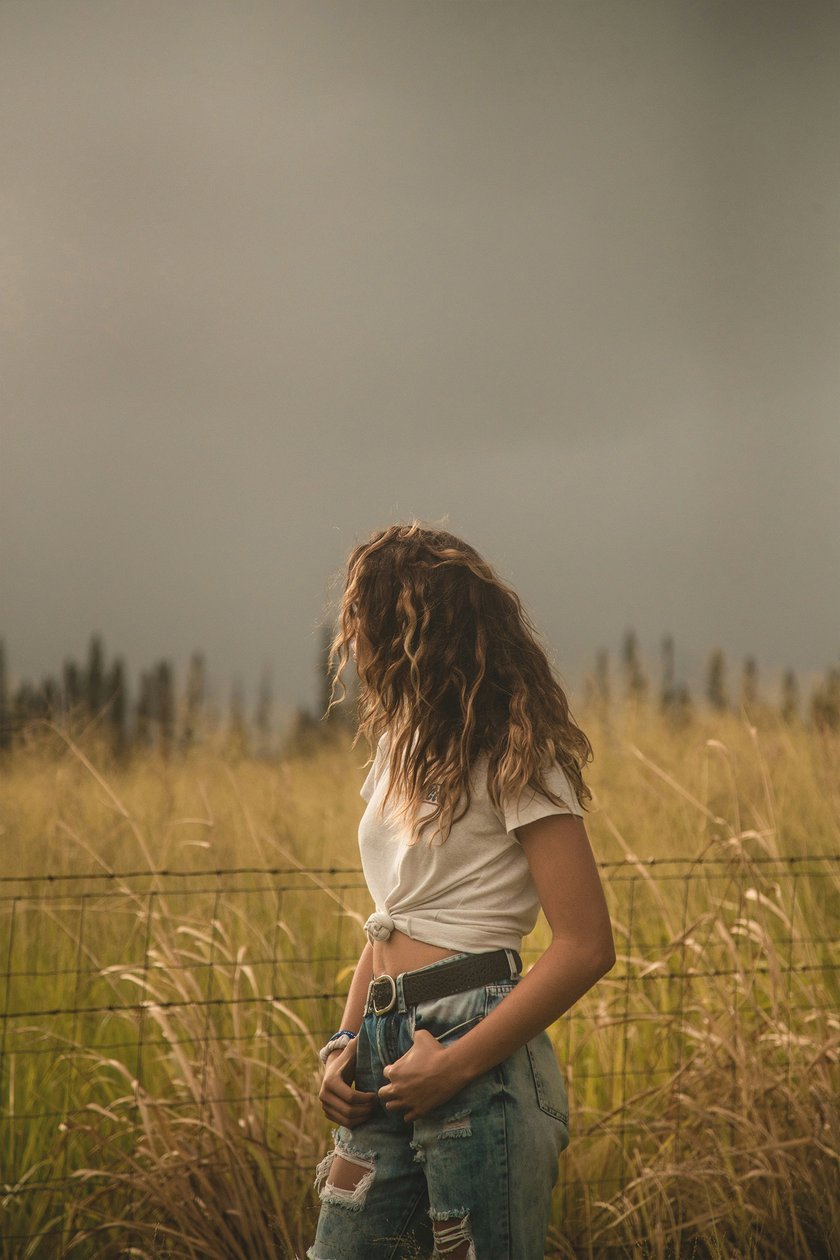Cloudy Day Portrait Photography: How To Work With Diffused Light
July 11, 2024

Master the art of portrait photography on overcast days with our guide to utilizing soft, natural light. Elevate your photography game now!
Sunny days, with their warm glow, striking shadows, and the vast opportunities the golden hour offers, make photography a delight. Often as photographers, we aim to schedule outdoor shoots on such days, as they promise striking imagery. But what happens when the sun doesn’t want to come out to play? The shadows, rich tones, and warmth vanish from your composition, so is it still worth venturing out? The short answer is most certainly yes. While many ideas might be off the table, there's still plenty we can achieve on a cloudy day.
In this article, we'll explore shooting outdoors with models under overcast skies, where the light is diffused and shadows are soft. Let's dive in.
Perfect Your Portraits with Precision Skin Retouching
Explore ApertyUnderstanding Diffused Light
 Firstly, consider what a diffuser does in a studio setting for portrait photography. With a single light source and a bare bulb, parts of our model's face will be well-lit, but there will be pronounced shadows. Depending on the light's position, the nose might cast a dense shadow on the cheek or above the lips. Now, introduce a diffuser over our light source. The light now distributes more evenly across the face, softening shadows or making them barely noticeable.
Firstly, consider what a diffuser does in a studio setting for portrait photography. With a single light source and a bare bulb, parts of our model's face will be well-lit, but there will be pronounced shadows. Depending on the light's position, the nose might cast a dense shadow on the cheek or above the lips. Now, introduce a diffuser over our light source. The light now distributes more evenly across the face, softening shadows or making them barely noticeable.
Let's take this concept outdoors. Envision a sunny day as akin to working with a bare bulb, and a cloudy day as equivalent to using diffused light; a cloudy sky acts like one gigantic softbox. Studio photographers frequently use diffused light, so it stands to reason that we can still achieve excellent results outdoors on overcast days.
Advantages of Soft Light
Studio photographers favour diffused light for several reasons:
- It’s Flattering: Softer light softens features, creating a smoother appearance on the skin, while harsh light can accentuate wrinkles, blemishes, and other imperfections.
- It’s Less Distracting: With light spread more evenly across the subject, we avoid the stark contrast between harsh highlights and deep shadows that direct sunlight creates. Although using shadows can be striking, if you want to divert attention elsewhere, soft, diffused light is preferable.
- Reduces Glare: If your model's face is shiny, it will be exacerbated by harsh light. This can be time-consuming to correct during post-processing. However, on overcast days with diffused light, glare is significantly reduced, and shiny skin is unlikely to be an issue.
- Increases Comfort: Models can relax their faces in softer light conditions. It can be taxing for the model to maintain a relaxed pose with bright light in their face, as their instinct may be to squint. This is also beneficial for the photographer, as it results in a more natural and relaxed pose to work with.
- Enhances Colours: While sunny days can make some colours pop, they can also bleach them out. Cloudy days, however, can enhance rich tones within the model’s outfit and appearance, closely matching the original colour without interference from the sun.
Both sunny and cloudy days have their merits, but it all depends on the mood you aim to capture within your image and the stories you wish to convey. In the following section, we'll ensure your camera settings are optimised for overcast days, so you can achieve sharp and high-quality images.
Camera Settings for Cloudy Weather
 Cloudy days present unique challenges for photographers, characterised by lower light conditions and varying degrees of cloud cover.
Cloudy days present unique challenges for photographers, characterised by lower light conditions and varying degrees of cloud cover.
White Balance
Start with a critical setting for overcast skies. It's important to switch off the automatic white balance and adjust this setting manually. Light conditions can fluctuate significantly during a cloudy day, resulting in your white balance shifting from warmer to cooler tones. This can become time-consuming to correct during post-processing, so adjust your white balance accordingly for consistent results. Some cameras even have a cloudy day white balance preset that you can experiment with.
ISO
Cloudy days can result in lower light conditions, tempting you to increase your ISO. Before doing so, consider adjusting your aperture and shutter speed to compensate. This helps to reduce unwanted noise.
Best ISO For Portraits: Sharp Details, Flawless Shots
Learn moreAperture
The choice of aperture depends on the mood you're targeting. For portraits with a blurred background, you might open your aperture as wide as possible, which allows more light into the lens and reduces the need to increase your ISO. Given the reduced shadows and contrast on cloudy days, a blurred background can effectively isolate your model. Alternatively, you might prefer to use your lens’ sweet spot for extra sharp images, but this might require adjusting your shutter speed and ISO to let in more light.
Carefully consider your settings depending on the mood you aim to capture. Cloudy days are all about experimentation, so be sure to fire off a few test shots before getting started.
Choosing the Right Location
 When planning shoots for cloudy days, it’s beneficial to lean into the characteristics overcast skies bring. Cloudy conditions are ideal for capturing muted or deep tones and adopting a minimalist approach. Here are some location ideas to consider for creating the perfect mood in your portrait sessions.
When planning shoots for cloudy days, it’s beneficial to lean into the characteristics overcast skies bring. Cloudy conditions are ideal for capturing muted or deep tones and adopting a minimalist approach. Here are some location ideas to consider for creating the perfect mood in your portrait sessions.
Concrete Backdrops: In a previous discussion on architecture photography, we highlighted how Brutalist architecture complements overcast conditions. This principle also applies to portraiture. Using concrete backdrops provides a muted, minimalist aesthetic. Styling your shoot with the model wearing darker tones can create a striking contrast against a lighter concrete backdrop.
Foliage: The rich green tones of leaves work wonderfully under soft light, which enhances the colours. Complementary colours like reds, blues, and darker tones can create a striking contrast amidst the foliage, adding depth to your image.
Murals and Painted Walls: Murals and brightly painted walls can achieve vivid, saturated colours that make your portraits pop. Ensure the colours of your model’s outfit harmonise with the vibrant backdrop to enhance the visual impact.
Urban Streets: The city streets offer a wealth of textures and colours to explore. Look for interesting elements like metal fences, brick walls, or storefronts that can serve as engaging backdrops. The diffused light of cloudy days softens the harsh textures, providing a more flattering light for portraits.
Mountains and Nature: The ruggedness of harsh landscapes is softened under the diffused light of an overcast sky, providing a grand yet subdued backdrop for your model. Natural elements like tree bark, open fields, and bodies of water also serve as excellent settings, benefiting from the lack of glare and harsh shadows.
Whether you're in a bustling city or the serene countryside, overcast days can help you achieve striking portraits. Let’s explore some creative ideas in the next section to incorporate into your shoot.
Creative Techniques and Composition
 The possibilities for creative portraits on cloudy days are endless. Without the distraction of harsh light and dense shadows, we can better focus attention on our subjects.
The possibilities for creative portraits on cloudy days are endless. Without the distraction of harsh light and dense shadows, we can better focus attention on our subjects.
Minimalism and Silhouettes
Find a light or dark background to contrast with our model and their outfit. By introducing minimal colours, we can create a silhouette of our model, delivering an eye-catching piece of work. For example, a dark stony background contrasted with our model wearing all-white clothing, or a brighter background such as concrete, with our model wearing all-black clothing.
Colour
Conversely, you can lean into the colourful opportunities that cloudy days present. Whether that is to have a single pop of colour, such as a plain dark background with a model wearing a vividly coloured outfit, or an array of colours, the choice is yours. Just remember to ensure that colours complement and not clash.
Moody Portraits
With cloudy days, we can achieve moody portraits. This can be done anywhere, from the city streets to the beach. The overcast skies will allow you to create mood with a lower exposure, outfit choice, and backdrop. Steer clear of flowers and bright murals, and opt for textures and darker backgrounds.
Black and White
You can strip away all colour and go for even moodier portraits with black and white. The even light will allow you to create flattering portraits of your model, with a stylish black and white overlay that will be especially striking. Black and white shots further smooth skin and conceal blemishes and imperfections, allowing you to achieve an even more flattering portrait.
Rainy Portraits
Add further interest to your cloudy day shots if it also happens to be raining. You can make use of reflections with puddles on the floor, and using umbrellas as props. You can further enhance your image by bringing out the textures of raindrops on your model’s face.
Foggy Portraits
Enhance the mood with foggy portraits. The dense fog and overcast sky will add a mysterious appeal to your image, which you can further enhance with your choice of mood and pose for your model. Foggy portraits will look good in any environment, and you can either lean into the muted tones or try and bring in a pop of colour to attract the attention of the viewer.
To a certain extent, cloudy days can restrict a photographer with some ideas they may want to try out, especially if they were planning on bright shots with dense shadows. However, a whole new world of creative possibilities opens up on overcast days, and certain moody looks that wouldn’t actually be achievable on sunny days become much easier to manage. So get creative, experiment and see how a cloudy day can benefit your shoot.
Mastering the Art of Street Portrait Photography (+Pro Ideas)
Learn moreThe Bottom Line
Just because the sun isn’t shining doesn’t mean photographers should pack up and head home. In fact, overcast days can be incredibly beneficial. Thanks to the diffused light of a cloudy day, features are softened and skin imperfections, wrinkles, and blemishes become less noticeable than they would be under harsh sunlight. This means photographers have less post-processing work to do. Soft light flatters, which is why studio photographers frequently use softboxes for portrait work. You’ll notice in beauty shoots that shadows are softer and the lighting is even across the face. Similarly, we can achieve this effect outdoors on a cloudy day, with the clouds acting as one giant softbox to help diffuse the sunlight.
In such conditions, we can embrace a moody look aided by overcast skies, or we can opt for a muted aesthetic and minimalist approach to create a stylistic image. Cloudy days also help to saturate colours and bring out the richness of tones, whereas sunny days might bleach them out. We can work with colourful images, vivid outfits and vibrant backdrops to create eye-catching compositions.
Overall, cloudy days are simply fun to work with. There is so much we can achieve under these conditions, so head outside and experiment with the vibe you are going for—you certainly won’t be disappointed.






